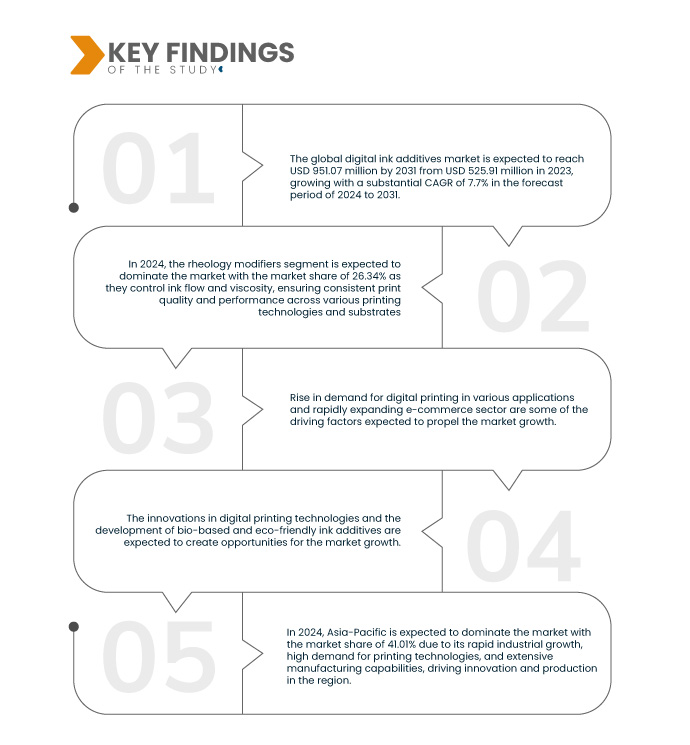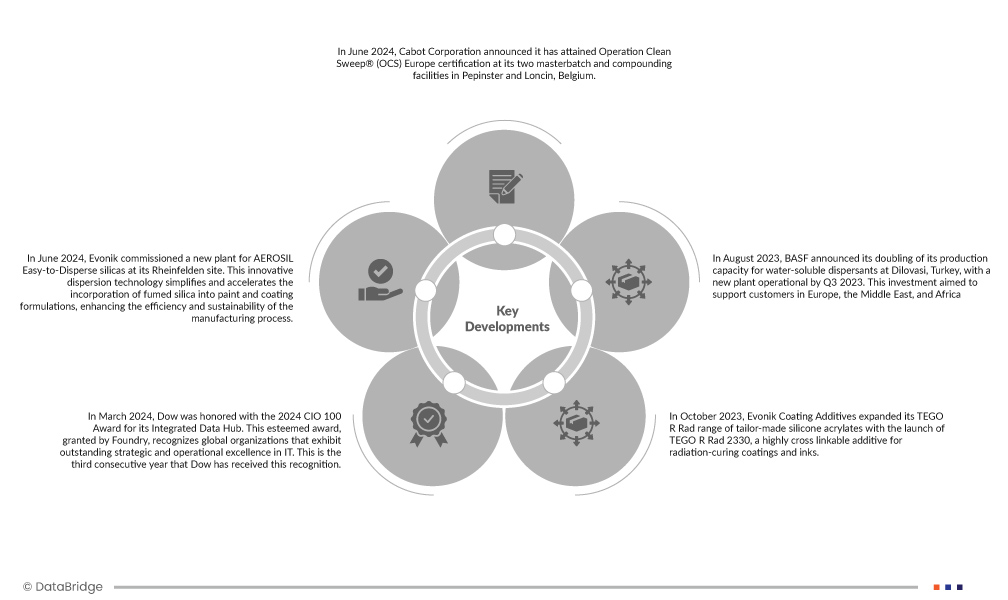Digital ink additives are substances added to digital inks to improve their performance and properties. These additives enhance color vibrancy, drying time, adhesion, and durability of the ink. They help the ink to flow smoothly through the printer, stick well to different surfaces, and remain stable over time. Applications of digital ink additives includes improving printing quality for high-resolution images and text, speeding up drying to prevent smudging, enhancing adhesion on various materials like paper, plastic, and metal, and increasing resistance to water, UV light, and physical wear. These additives are essential in industries such as packaging, textiles, and commercial printing, where high-quality and durable prints are crucial.
Access Full Report @ https://www.databridgemarketresearch.com/jp/reports/global-digital-ink-additives-market
Data Bridge Market Research analyses that the Digital Ink Additives Market is expected to reach USD 951.07 million by 2031 from USD 525.92 million in 2023, growing with a substantial CAGR of 7.7% in the forecast period of 2024 to 2031.
Key Findings of the Study
Rapidly Expanding E-Commerce Sector
E-commerce platforms have revolutionized the retail landscape, creating a surge in demand for digital printing solutions. As online shopping becomes more prevalent, the need for high-quality, visually appealing packaging has increased. This demand directly impacts the digital ink additives market, as these additives play a crucial role in enhancing the quality, durability, and vibrancy of printed materials. Companies are increasingly investing in advanced digital printing technologies to meet consumer expectations, thereby boosting the market for digital ink additives.
Report Scope and Market Segmentation
|
Report Metric |
Details |
|
Forecast Period |
2024 to 2031 |
|
Base Year |
2023 |
|
Historic Years |
2022 (Customizable from 2016-2021) |
|
Quantitative Units |
Revenue in USD Million |
|
Segments Covered |
Type (Rheology Modifiers, Wetting Agents, Foam Control Additives and Defoamers, Slip/Rub Types, Anti-Oxidants, Film Forming Agents, Photo-Oxidizer, Anti-Skinning Agent, PH Stabilizers, and Others), Formulation (Water-Based, Solvent-Based, UV or Radiation Cured, and Others), Application (Printing, Packaging, Publication, Textiles, Advertising, Electronics, Automotive, Ceramic (Industrial), and Others) |
|
Regions Covered |
U.S., Canada, Mexico, China, Japan, India, South Korea, Taiwan, Singapore, Thailand, Australia, Malaysia, Indonesia, Philippines, New Zealand, Rest of Asia-Pacific, Germany, U.K., Italy, France, Spain, Switzerland, Russia, Turkey, Belgium, Netherlands, Rest of Europe, Brazil, Argentina, Rest of South America, South Africa, U.A.E., Saudi Arabia, Egypt, Israel, Rest of Middle East and Africa |
|
Market Players Covered |
UNIQCHEM (Germany), Münzing Corporation (Germany), The Lubrizol Corporation (U.S.), Eastman Chemical Company (U.S.), Syensqo (Belgium), Honeywell International Inc. (U.S.), CHONGQING ACME TECH. CO., LTD., ALTANA AG (Germany), Elementis PLC (U.K.), DOW (U.S.), Allnex GMBH (Germany), Croda International Plc (U.K.), Cabot Corporation (U.S.), Evonik Industries AG (Germany), BASF SE (Germany), and Ashland (U.S.) among others |
|
Data Points Covered in the Report |
In addition to the insights on market scenarios such as market value, growth rate, segmentation, geographical coverage, and major players, the market reports curated by the Data Bridge Market Research also include depth expert analysis, patient epidemiology, pipeline analysis, pricing analysis, and regulatory framework |
Segment Analysis:
Global digital ink additives market is segmented into three notable segments based on type, formulation and application.
- On the basis of type, the market is segmented into rheology modifiers, wetting agents, foam control additives and defoamers, slip/rub types, anti-oxidants, film forming agents, photo-oxidizer, anti-skinning agent, pH stabilizers, and others
In 2024, the rheology modifiers segment is expected to dominate the market
In 2024, the rheology modifiers segment is expected to dominate the market with a market share of 26.34% as they control ink flow and viscosity, ensuring consistent print quality and performance across various printing technologies and substrates.
- On the basis of formulation, the market is segmented into water-based, solvent-based, UV or radiation cured, and others
In 2024, the water-based segment is expected to dominate the market
In 2024, the water-based segment is expected to dominate the market with a market share of 43.84% due to their eco-friendly properties, lower VOC emissions, and ease of cleanup, making them a preferred choice for sustainable and efficient printing solutions.
- On the basis of application, the market is segmented into printing, packaging, publication, textiles, advertising, electronics, automotive, ceramic (industrial), and others. In 2024, the printing segment is expected to dominate the market with a market share of 26.01%
Major Players
Data Bridge Market Research recognizes the following companies as the major key players in the global digital ink additives market are BASF SE (Germany), DOW (U.S.), Evonik Industries AG (Germany), Cabot Corporation (U.S.), and ALTANA AG. (Germany) among others.
Market Development
- In June 2024, Cabot Corporation announced it has attained Operation Clean Sweep® (OCS) Europe certification at its two masterbatch and compounding facilities in Pepinster and Loncin, Belgium. As one of the first black masterbatch manufacturers in Europe to earn this third-party certification, Cabot underscores its commitment to responsible plastic management practices, aiming to reduce plastic waste in the environment
- In June 2024, Evonik commissioned a new plant for AEROSIL Easy-to-Disperse silicas at its Rheinfelden site. This innovative dispersion technology simplifies and accelerates the incorporation of fumed silica into paint and coating formulations, enhancing the efficiency and sustainability of the manufacturing process. The expansion at Rheinfelden strengthens the global availability of high-quality silica and marks a significant step towards providing eco-friendly solutions for the paint and coatings sector
- In March 2024, Dow was honoured with the 2024 CIO 100 Award for its Integrated Data Hub. This esteemed award, granted by Foundry, recognizes global organizations that exhibit outstanding strategic and operational excellence in IT. This is the third consecutive year that Dow has received this recognition
- In October 2023, Evonik Coating Additives expanded its TEGO R Rad range of tailor-made silicone acrylates with the launch of TEGO R Rad 2330, a highly crosslinkable additive for radiation-curing coatings and inks. TEGO R Rad 2330 offers excellent wetting, anti-crater, flow, slip, and release properties for radiation-curing varnishes, inks, and coatings. It features low foaming and is recommended for both traditional and UV-LED curing techniques. Its high crosslinkability ensures minimal migration and good cost efficiency
- In August 2023, BASF announced its doubling of its production capacity for water-soluble dispersants at Dilovasi, Turkey, with a new plant operational by Q3 2023. This investment aimed to support customers in Europe, the Middle East, and Africa. In 2020, BASF had expanded its Ludwigshafen site. The Sokalan® range of dispersants and additives catered to detergents, cleaning, and chemical processing industries. The expansion addressed rising demand and enhanced supply reliability for European customers
Regional Analysis
On the basis of geography, the market is segmented into five regions, namely, North America, Europe, Asia-Pacific, South America and Middle East and Africa. These regions are further segmented into U.S., Canada, Mexico, China, Japan, India, South Korea, Taiwan, Singapore, Thailand, Australia, Malaysia, Indonesia, Philippines, New Zealand, rest of Asia-Pacific, Germany, U.K., Italy, France, Spain, Switzerland, Russia, Turkey, Belgium, Netherlands, rest of Europe, Brazil, Argentina, Rest of South America, South Africa, U.A.E., Saudi Arabia, Egypt, Israel, rest of Middle East and Africa.
As per Data Bridge Market Research analysis:
Asia-Pacific is the dominant and fastest growing region in the global digital ink additives market
Asia-Pacific is the dominant and is estimated to be the fastest growing region in the market due to its rapid industrial growth, high demand for printing technologies, and extensive manufacturing capabilities, driving innovation and production in the region.
For more detailed information about the global digital ink additives market report, click here – https://www.databridgemarketresearch.com/jp/reports/global-digital-ink-additives-market















